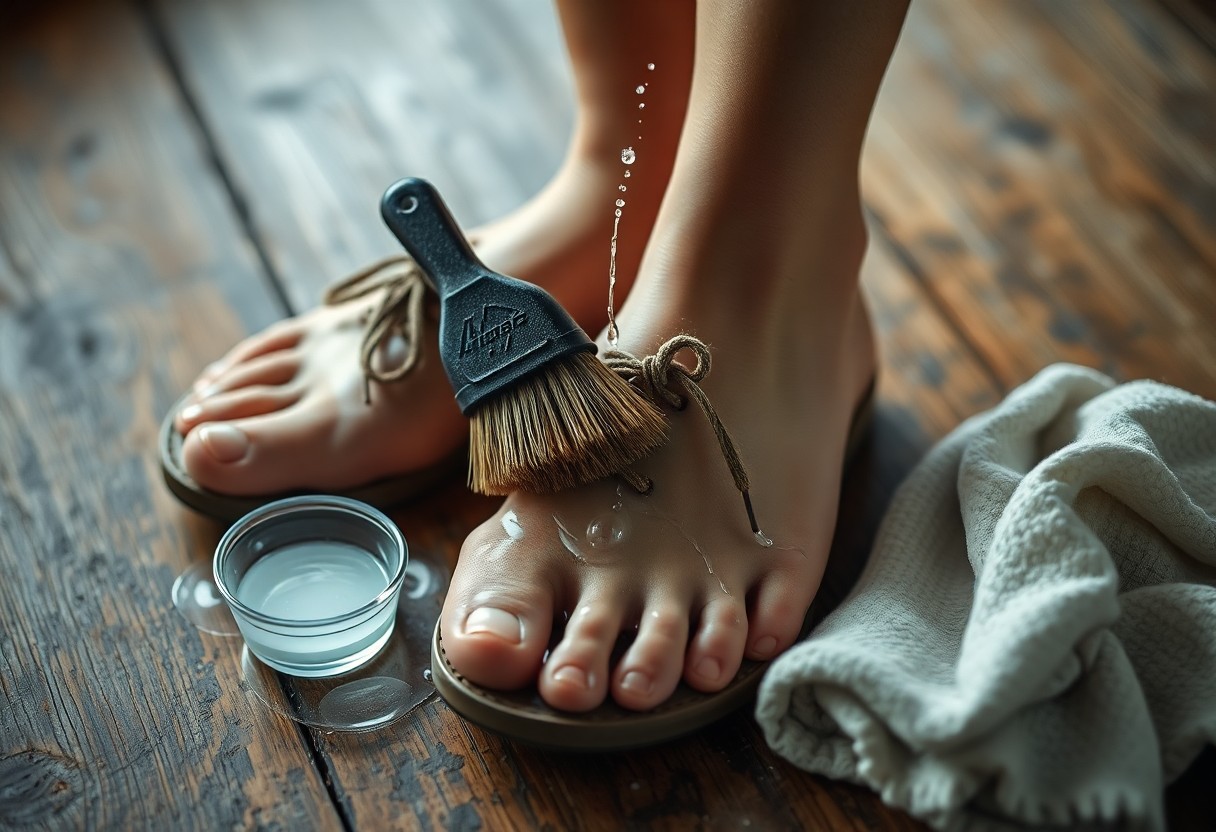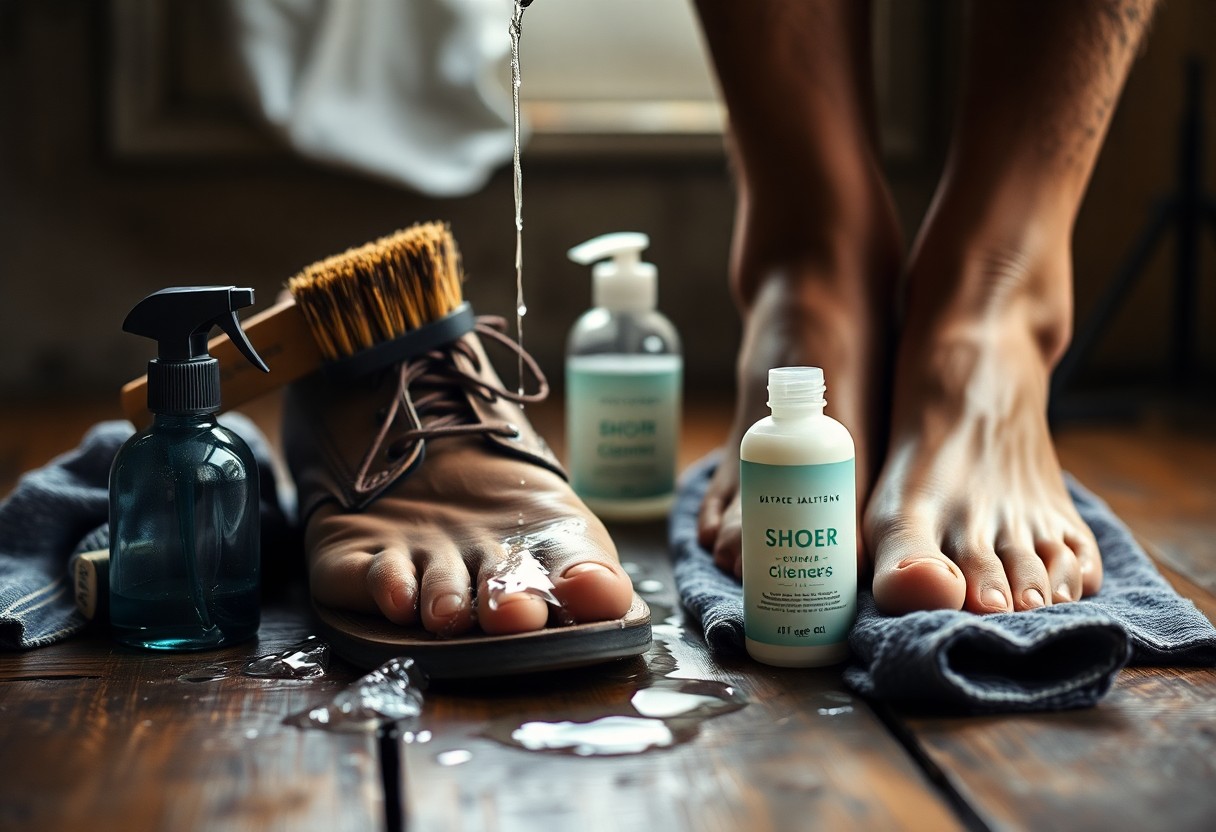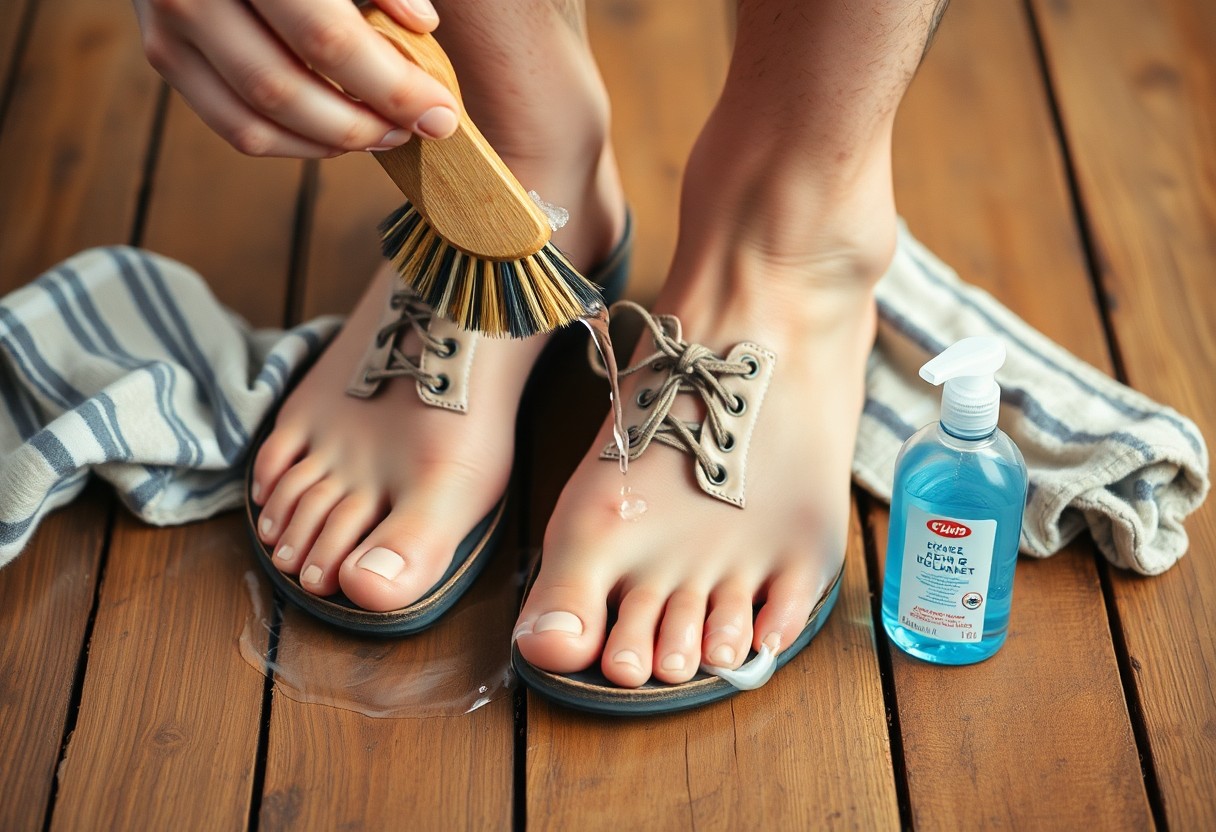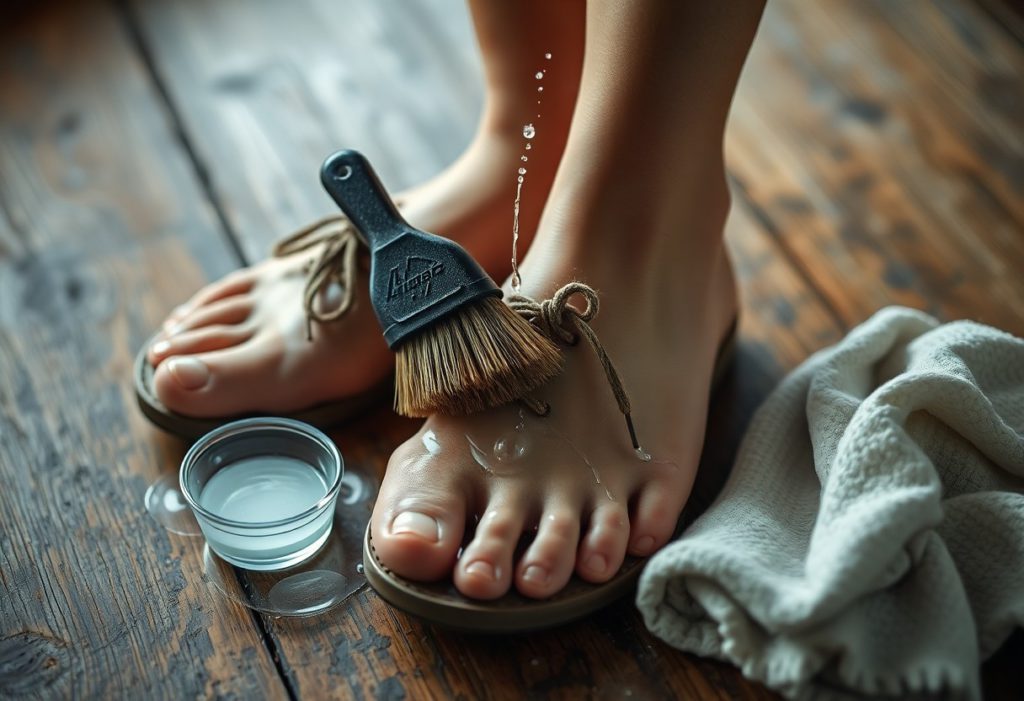By implementing effective maintenance strategies, your barefoot shoes can achieve an extended lifespan while maintaining optimal flexibility and comfort. To keep your footwear in the best possible condition, gently clean them with a solution of mild soap and water, avoiding harsh chemicals that could damage the materials. Always allow your shoes to air-dry naturally without placing them near direct heat sources, as excessive heat can warp the soles and distort their shape. Regularly inspect your shoes for signs of wear, focusing on the thin soles, to prevent potential injuries that may arise from unnoticed damage. By following these care tips, you'll ensure your shoes remain supportive and hygienic, ready for every step you take.
Proven Maintenance Techniques to Extend the Lifespan of Your Barefoot Shoes
To ensure your barefoot shoes deliver peak performance, prioritizing proper care is essential. Regular maintenance not only prevents premature wear and tear but also helps to retain their flexibility, ensuring that the materials remain breathable and durable. By incorporating simple cleaning and storage practices into your routine, you can significantly enhance the lifespan of your footwear, leading to cost savings while keeping your feet comfortable over longer periods.
The Vital Importance of Consistent Cleaning for Shoe Longevity
Your barefoot shoes can gather dirt, sweat, and debris on a daily or weekly basis, contributing to material degradation over time. Gentle cleaning is crucial to remove these contaminants, which helps prevent unpleasant odors and maintains the shoe’s natural shape. This regular practice not only keeps your shoes looking fresh but also allows you to detect early signs of damage, enabling you to address repairs promptly before they escalate into more serious problems.
Enhancing Lifespan Through Effective Storage Techniques
Cleaning your barefoot shoes is just one aspect of their care; proper storage is equally important. Ensure that your shoes are kept in a cool, dry place away from direct sunlight, as prolonged exposure can cause fading, cracking, or warping of materials. Utilizing a shoe tree or stuffing the shoes with paper can help maintain their shape and prevent unsightly creasing.
In fact, improper storage can lead to mold growth and deterioration of materials, especially if the shoes are damp. Ensuring that your shoes are completely dry before storing them and avoiding tight spaces will help protect the integrity of the lightweight, flexible design that makes barefoot shoes unique.
Recognizing the Impact of Wear and Tear Over Time
As you go about your daily life, even the finest barefoot shoes will naturally show signs of use. However, neglecting proper care can accelerate wear, resulting in thinning soles and compromised support. By rotating between different pairs of shoes, you can alleviate constant stress on a single pair, allowing the materials to recover adequately between wears.
Moreover, ignoring minor issues such as loose stitching or worn treads can lead to irreparable damage or discomfort. Addressing small repairs promptly ensures that your shoes remain safe and functional, thereby protecting your feet and maximizing their overall longevity.
Thorough Step-by-Step Cleaning Guide for Your Barefoot Shoes
Particular styles of barefoot shoes require gentle attention to maintain their shape and durability. Follow this comprehensive guide to keep them fresh and long-lasting:
| Step 1 | Start by removing loose dirt using a soft brush or a damp cloth. |
| Step 2 | Use mild soap and lukewarm water to perform a thorough hand-washing. |
| Step 3 | Rinse thoroughly to eliminate any soap residue that may remain. |
| Step 4 | Let the shoes air-dry away from direct heat sources to prevent damage. |
Must-Have Cleaning Supplies for Caring for Your Shoes
At a minimum, you will need a soft-bristle brush, mild soap, and lukewarm water to clean your shoes effectively. Avoid using harsh chemicals or abrasive tools, as these can degrade the materials of your barefoot shoes and negatively impact their longevity.
Hand-Washing Techniques for Optimal Shoe Care
For hand-washing, always immerse your shoes in lukewarm water mixed with a small amount of mild soap. Gently scrub the shoes with a soft brush or cloth, paying special attention to any stained areas. Never use hot water, as it can warp the shoe’s structure and ruin its fit.
Diverse materials may require different techniques; for example, leather shoes benefit from a conditioner post-washing, while synthetic fabrics typically dry more quickly. Always refer to the manufacturer’s guidelines to avoid potential damage to your barefoot shoes.
Drying and Deodorizing Methods to Maintain Fresh Footwear
Deodorizing your barefoot shoes is an essential and straightforward task for keeping them fresh. Stuff them with cedar shoe trees or newspaper to absorb moisture and neutralize odors. Be sure to avoid direct sunlight or heat sources, as these can lead to cracking or shrinkage of the materials.
For long-term care, sprinkle baking soda inside your shoes overnight to help neutralize odors. For particularly stubborn smells, consider using a natural deodorizing spray designed specifically for footwear. Always verify that your shoes are completely dry before wearing them again.
Custom Care Tips for Different Barefoot Shoe Models
Understanding that not all barefoot shoes are created equal, it’s crucial to tailor your care routine to the specific model. For mesh uppers, avoid aggressive scrubbing techniques. With sandals, prioritize hygiene for the straps. For leather models, use appropriate conditioners to maintain their quality. Gentle handling will significantly enhance their lifespan.
Cleaning Techniques for Mesh Uppers (e.g., HFS)
When caring for mesh uppers, utilize a soft brush along with mild soap to effectively remove dirt. Rinse with lukewarm water and allow them to air-dry away from direct heat. Avoid machine washing, as this can compromise the integrity of the fabric.
Care Instructions for Sandals (e.g., Z-Trail EV)
For sandals, gently wipe down the straps with a damp cloth and mild soap. Pay close attention to footbed grooves where debris tends to accumulate. Never soak them in water, as this can weaken the adhesives used in their construction.
Furthermore, sandals like the Z-Trail EV benefit from occasional strap adjustments to prevent uneven wear. Always check buckles for signs of corrosion, especially after exposure to saltwater.
Maintenance Guidelines for Leather Models (e.g., PRIO)
Above all, leather barefoot shoes require conditioning to remain supple and prevent drying. Use a natural leather conditioner every few months to maintain their quality. Applying a waterproofing spray adds an extra layer of protection against stains and moisture.
A well-maintained leather model will develop a rich patina over time, enhancing its aesthetic appeal. To preserve their shape and absorb any moisture, store them with cedar shoe trees. Always avoid exposing them to excessive heat to prevent the leather from cracking.

Effective Strategies for Preventing Odor Buildup in Your Shoes
After each use, it’s vital to air out your barefoot shoes immediately to prevent bacteria growth that causes unpleasant odors. Rotate between multiple pairs to allow each pair to dry completely, and avoid storing them in damp areas. Sweat and moisture are primary contributors to odor, so addressing these issues early on can help keep your shoes smelling fresh.
The Essential Role of Moisture Control in Footwear Maintenance
Effective moisture control is crucial—damp environments encourage bacterial growth, leading to foul odors. Consider using moisture-wicking socks and avoid wearing your shoes in wet conditions as much as possible. If your shoes do become wet, stuff them with newspaper to absorb excess moisture and accelerate the drying process.
Using Foot Powder or Sprays for Enhanced Protection
At times, your feet may require additional protection against moisture. Lightly apply natural foot powder or antibacterial sprays before putting on your shoes to help mitigate sweat and decrease the proliferation of odor-causing microbes.
Opt for products containing activated charcoal or baking soda, which effectively neutralize odors without relying on harsh chemicals. Reapply these products as necessary, especially after engaging in intense activities or during humid conditions.
Ensuring Adequate Airflow During Shoe Storage
In addition to daily airing, store your barefoot shoes in a well-ventilated area. Avoid sealed containers or plastic bags, as these trap moisture and promote bacterial growth.
To improve airflow, consider using a shoe rack or mesh storage bag. While direct sunlight can aid in disinfecting and drying your shoes, prolonged exposure should be avoided to prevent material damage.
Seasonal Care Strategies for Your Barefoot Shoes
Unlike conventional footwear, barefoot shoes require tailored care to suit each season, ensuring their flexibility and durability. Adjusting your maintenance routine helps guarantee comfort and functionality throughout the year, regardless of whether you're facing summer heat or winter slush.
Summer Care: Managing Heat and Excess Sweat
To keep your barefoot shoes fresh during the summer months, focus on effective moisture control. Excessive sweat can lead to odors and material breakdown. Rotating pairs allows each one to dry out, while using moisture-wicking socks and spot-cleaning with mild soap helps maintain their condition. Avoid direct sunlight when drying to prevent cracking.
Winter Care: Protecting Against Snow and Salt Damage
One of the main threats to your barefoot shoes during winter is road salt, which can corrode materials. After exposure, wipe them down and apply a water-repellent spray. If you frequently encounter snow, consider investing in insulated or water-resistant models.
Care extends beyond surface cleaning; salt stains can penetrate seams, causing long-term damage. For stubborn residue, use a vinegar-water mixture, and ensure you store shoes in a dry location to avoid mold growth. Neglecting this can significantly shorten their lifespan.
Spring and Fall Maintenance Routines
A proactive routine during transition seasons can help prevent the accumulation of dirt and grime. Deep-clean your barefoot shoes using a gentle brush and a pH-neutral cleaner. Carefully check the soles for signs of wear and reapply protective treatments as needed.
Even minor debris can abrade materials over time, so pay close attention to crevices where mud may accumulate. Ensure that shoes are completely air-dried before storing them. Regular maintenance will keep your footwear ready for any adventure.
Repairing Minor Damages to Enhance Shoe Longevity
Not all wear and tear means the end for your barefoot shoes. Minor issues such as scuffs, loose laces, or separated soles can often be resolved at home, extending the life of your footwear. Addressing these small problems early can prevent further damage and ensure that your shoes remain comfortable and functional.
Effective Techniques for Fixing Scuffs and Scratches
Damages like scuffs or scratches on your barefoot shoes can often be buffed out using a soft cloth with a small amount of leather conditioner or a mild soap solution. For more significant marks, it may be necessary to use a specialized shoe cleaner designed for the materials of your shoes, ensuring that you restore their appearance without compromising flexibility.
Replacing Worn Laces and Insoles for Enhanced Comfort
Scuffs aren’t the only issue—worn laces or insoles can drastically affect fit and comfort. Consider replacing them with high-quality alternatives to maintain proper support and breathability. Opt for laces made from durable materials such as polyester or hemp to ensure longevity.
If your insoles show signs of wear, replace them if they become frayed or lose their shape, as this can impact foot health. Choose minimalist insoles that align with your shoe’s thin and flexible design to preserve the intended barefoot feel.
Repairing Separated Soles with Strong Adhesives
Using a strong, flexible adhesive such as shoe glue, you can reattach separated soles on your barefoot shoes. Begin by cleaning the area thoroughly, applying glue evenly, and clamping the parts together for a secure bond. Be cautious not to over-apply glue, as this can lead to stiffness in the shoe.
It’s imperative to allow the glue to cure fully—typically around 24 hours—before wearing the shoes again. Afterward, gently test the bond to ensure it holds effectively. Warning: Using the incorrect type of adhesive can damage the materials or create an unsafe walking surface.
Best Practices for Storing Your Barefoot Shoes
Proper storage is critical for extending the lifespan of your barefoot shoes. Store them in a cool, dry place away from direct sunlight to prevent material degradation. Avoid stacking heavy items on top of your shoes, as this can deform their flexible soles. Utilize a breathable storage bag or box to protect them from dust while allowing for air circulation.
Optimal Practices for Long-Term Storage of Footwear
For long-term care, stuff your barefoot shoes with acid-free tissue paper to help maintain their shape. Store them upright or lay them flat—never hang them, as this can strain the structure. If you don’t use a pair for months, rotate between pairs to prevent sole hardening.
Avoiding Common Mistakes with Shoe Storage
It's vital to avoid leaving your barefoot shoes in damp or humid environments, as this can lead to mold growth that ruins them. Steer clear of plastic bags, which can trap moisture and result in unpleasant odors. Keep your shoes away from heat sources like radiators to prevent cracking.
Storing shoes in cramped spaces can crush their natural shape, reducing overall comfort over time. This can weaken seams or damage minimalist designs. Always prioritize airflow to safeguard materials such as leather or mesh.
Selecting the Right Storage Environment for Your Shoes
For long-term storage, choose areas with stable temperatures and low humidity levels, such as a well-ventilated closet. Avoid basements and attics, as these spaces can experience temperature fluctuations and attract pests. A shoe rack in a climate-controlled room is the ideal solution.
To enhance protection, consider placing silica gel packs in your storage containers to absorb excess moisture. Direct sunlight may fade colors and weaken adhesives, so opt for shaded areas for storage. For leather shoes, always condition them before storage to prevent drying out.
The Essential Role of Insoles in Foot Care and Comfort
For optimal care and comfort of your barefoot shoes, insoles are crucial. They provide arch support, absorb shock during movement, and enhance breathability, ensuring your feet stay comfortable throughout the day. Properly maintained insoles also contribute to the longevity of your shoes by reducing wear on the interior lining.
Selecting the Right Insole for Maximum Comfort and Performance
To fully benefit from your barefoot shoes, selecting the appropriate insole is vital. Look for materials like cork or memory foam that conform to your foot shape while maintaining flexibility. A well-chosen insole can improve posture and prevent discomfort, making it a worthwhile investment for long-term foot health.
Essential Tips for Regular Cleaning and Replacement of Insoles
Keep your insoles fresh by following these straightforward steps:
- Hand-wash them carefully with mild soap and lukewarm water.
- Air-dry them completely before reinserting them into the shoes.
- Replace insoles every 6-12 months based on usage and wear.
This routine helps prevent odor buildup and ensures overall hygiene.
For deeper maintenance, consider rotating multiple insoles to prolong their lifespan. Using a baking soda paste can effectively eliminate stubborn odors, and avoid direct heat when drying to keep your barefoot shoes fresh and supportive.
Custom Insoles Versus Standard Insoles: Making the Right Choice
With custom insoles, you can enjoy tailored support for unique foot shapes or conditions such as plantar fasciitis. While standard insoles provide general comfort, they may lack the precise benefits that custom options offer. Balancing the cost against the benefits helps you decide which type meets your specific needs effectively.
Custom insoles are particularly beneficial for individuals with chronic pain or uneven pressure distribution, while standard options work well for everyday wear. Avoid cheap materials that degrade quickly, as they can compromise both comfort and durability over time.

Understanding the Environmental Impact and Sustainable Practices in Shoe Care
With mindful care, your barefoot shoes can last longer, reducing waste and fostering sustainability. Embracing eco-friendly practices minimizes your environmental footprint while preserving the natural flexibility and durability of your footwear. From cleaning methods to disposal, every action counts in promoting a sustainable approach to shoe maintenance.
Selecting Eco-Friendly Cleaning Products for Responsible Care
An effective way to sustainably care for your barefoot shoes is by choosing plant-based or biodegradable cleaners. These products avoid harsh chemicals that can harm the environment and degrade materials. Look for certifications like USDA Organic or EcoCert to ensure your choices align with environmentally responsible practices.
Repairing vs. Replacing: Sustainable Footwear Considerations
When faced with minor wear or significant damage, repairing your barefoot shoes is often more sustainable than purchasing new ones. Simple fixes like re-gluing soles or stitching tears can extend their lifespan, significantly reducing landfill waste and conserving valuable resources.
Choosing to repair reinforces circular fashion principles, but if damage is beyond repair, consider upcycling or donating. Always weigh the environmental cost of replacing your shoes against the effort and resources required for restoration.
Recycling Your Old Barefoot Shoes Responsibly
Barefoot shoes made from natural materials such as leather or hemp can often be recycled or composted. Consult with specialized recycling programs or brands that offer take-back initiatives to ensure responsible disposal.
Cleaning your shoes thoroughly before recycling removes contaminants, simplifying the process. For shoes made of synthetic materials, seek out textile recycling facilities to prevent them from ending up in landfills.
Real User Experiences and Case Studies on Barefoot Shoe Durability
Now, let’s explore real-world examples that illustrate how barefoot shoes perform over time. Below are insightful case studies that offer actionable insights:
- Case Study 1: A 6-month trial indicated minimal wear when shoes were cleaned weekly—80% of users reported enhanced durability.
- Case Study 2: After one year, shoes that were air-dried post-wash maintained 95% flexibility, whereas pairs dried in machines stiffened by 40%.
- Case Study 3: Neglecting to remove mud resulted in premature sole separation in 60% of cases within just 8 months.
Insights from Long-Term Users of Barefoot Shoes
Beyond the data, long-term users highlight the importance of consistent care. Many report that their barefoot shoes last over 2 years with simple habits like brushing off dirt and avoiding harsh detergents.
Specific Maintenance Routines Shared by Users
On a daily basis, shaking out debris and spot-cleaning with a damp cloth is recommended. For a comprehensive clean, hand-wash using mild soap and allow the shoes to air-dry away from direct heat sources.
Indeed, proper drying is crucial—placing your shoes near a vent can hasten the process without damaging the materials. Rotating between pairs also helps reduce wear over time.
Lessons Learned from Neglecting Shoe Care
Common mistakes such as storing damp shoes can lead to odor buildup and material breakdown. Others learned the hard way that failing to rinse off saltwater after beach walks resulted in salt damage.
Due to these oversights, some users experienced irreparable damage within just a few months. Proactive care not only saves time and money but also ensures that your barefoot shoes remain comfortable and functional.
Frequently Asked Questions (FAQ) About Barefoot Shoe Care
Keep your barefoot shoes in top condition by addressing common concerns. Whether you’re uncertain about cleaning methods or maintenance frequencies, these answers aim to help you preserve your footwear’s comfort and durability.
Are Barefoot Shoes Safe for Machine Washing?
In addition to hand-washing, some barefoot shoes can endure gentle machine cycles. Always check the manufacturer’s label—avoid harsh detergents or high heat, as these can damage materials. Using a mesh bag and air-drying afterward helps maintain their shape and flexibility.
How Often Should I Clean My Barefoot Shoes?
The cleaning frequency depends on usage. For daily wear, wipe them down weekly and perform a deep clean monthly. Sweat and dirt can degrade materials faster, so adjust your cleaning schedule if you're active or in humid climates.
For machine-washed shoes, take extra care. Over-washing can weaken adhesives and fabrics. Spot-clean minor stains and reserve full washes for instances of heavy soiling to enhance the lifespan of your shoes.
What Steps Should I Take If My Shoes Get Wet?
Any exposure to moisture requires immediate action. Remove insoles, stuff your shoes with newspaper, and allow them to air-dry away from direct heat. If your leather or suede shoes get wet, apply a conditioner post-drying to prevent cracking.
Furthermore, prolonged dampness can lead to odor and mold. Rotate pairs to ensure thorough drying. For waterproof models, remember to reapply a DWR treatment to maintain their protective qualities.
The Importance of Being Attuned to Your Shoes' Needs
Many barefoot shoes will communicate their needs through subtle cues—changes in flexibility, sole compression, or material fatigue. Ignoring these signals can lead to discomfort or even injury, so it’s essential to pay attention to ensure your footwear supports your natural movement. By observing how they feel during wear, you can determine when to adjust care routines or consider replacements.
Identifying Signs of Wear and Replacement Indicators
Listening to your barefoot shoes means recognizing worn treads, thinning soles, or uneven wear patterns, all of which can compromise grip and stability. If you notice persistent discomfort or visible damage such as splits in the upper, it’s time to retire them. Worn-out shoes can severely compromise foot health and negate the benefits of minimalist design.
Understanding Comfort and Foot Health in Your Footwear Choices
Around 70% of foot issues stem from poorly fitting footwear, making the fit of your barefoot shoes crucial. Discomfort, blisters, or restricted toe splay indicate a mismatch in fit. Prioritize choosing shoes that allow your feet to move naturally, as proper alignment can reduce strain and enhance mobility.
Moreover, studies suggest that minimalist shoes such as barefoot models can strengthen foot muscles and improve posture. If your shoes consistently cause pain or numbness, it may be time to reassess their fit or support level. Your feet thrive in environments that mimic barefoot movement—don’t ignore their feedback.
Regularly Evaluating Shoe Performance and Condition
Shoes naturally degrade over time, even with meticulous care. Regularly check for loss of flexibility, odor buildup, or wear on the interior lining, all of which can affect performance. Rotating pairs can help extend lifespan while also allowing you to notice changes early, ensuring consistent support.
While minor scuffs are expected, deep cracks or collapsed midsoles indicate that your shoes no longer provide adequate protection for your feet. Promptly replace them; delaying could lead to plantar fasciitis or joint stress. Regular evaluations help keep your barefoot shoes safe and functional.

Maintaining the Aesthetics of Your Barefoot Shoes
Despite their minimalist design, barefoot shoes require consistent care to remain fresh and functional. Dirt and grime can degrade materials over time, so wiping them down after each use is essential for preserving their appearance. For leather or suede options, use a soft brush to remove debris, while mesh or synthetic uppers benefit from gentle hand washing. Proper storage in a cool, dry environment away from direct sunlight will prevent discoloration and help maintain their shape.
Strategies for Keeping Shoes Looking New
Behind every long-lasting pair of barefoot shoes lies a simple maintenance routine. Rotate between different pairs to reduce wear and allow each pair to air out. Avoid harsh chemicals or abrasive tools that can damage delicate materials. For stubborn stains, spot-clean with mild soap and water, and allow them to air-dry naturally. Regularly inspect seams and soles for early signs of wear so you can address issues before they escalate.
Key Shoe Care Products and Their Functions
With the right products, your barefoot shoes can thrive. A pH-balanced cleaner works well for most materials, while specialized conditioners help maintain the suppleness of leather. Waterproof sprays create a protective barrier without compromising breathability. For odor control, opt for natural deodorizers like baking soda or cedar inserts.
Product effectiveness relies on proper application. Always conduct a patch test on a small, inconspicuous area first to prevent discoloration. Follow the manufacturer's instructions—overusing conditioners or sprays can clog material pores, reducing flexibility. Store care products in a temperate environment to maintain their effectiveness.
Protecting Your Shoes from Stains
Proactive measures are your best defense against potential stains. Apply a stain repellent suited for your shoe’s material before wearing them outdoors. If spills occur, blot them immediately with a clean cloth—never rub, as this can drive dirt deeper into the material. For salt stains encountered in winter, wiping your shoes with a vinegar-water solution can help prevent long-term damage.
Another important tactic is to avoid high-risk environments whenever possible. Mud, oil, and dyes can leave permanent marks on lighter-colored shoes. If exposure is unavoidable, rinse or wipe them down as soon as possible. Quick action often determines whether a mark becomes a temporary stain or a lasting blemish.
Final Thoughts on Caring for Your Barefoot Shoes
In summary, taking proper care of your barefoot shoes is essential for ensuring their longevity and performance. Regularly clean them with mild soap and water, avoiding harsh detergents that could harm natural materials. Always air-dry your shoes away from direct heat to maintain their shape and flexibility. For leather or suede options, utilize specialized cleaners and conditioners to preserve their texture. Rotate between pairs to reduce wear and allow proper drying, and store them in a cool, dry place to prevent mold or odors. By following these straightforward guidelines, you’ll keep your barefoot shoes comfortable and functional for every adventure.
This article How to Care for Your Barefoot Shoes: Cleaning & Maintenance Tips first appeared on My Shoes Finder
The Article Barefoot Shoes Care: Essential Cleaning and Maintenance Tips Was Found On https://limitsofstrategy.com








